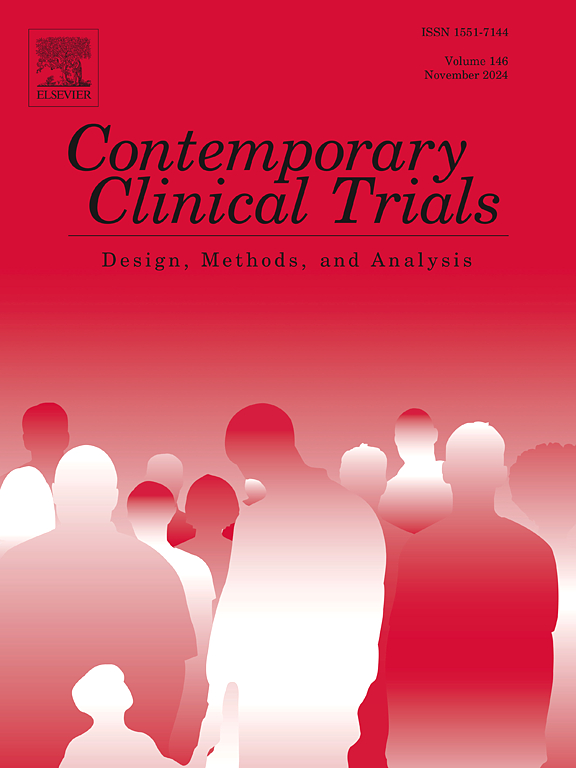一项多地点随机临床试验的社会辅助机器人参与老年人认知障碍居住在长期护理机构:协议文件。
IF 1.9
3区 医学
Q3 MEDICINE, RESEARCH & EXPERIMENTAL
引用次数: 0
摘要
冷漠在痴呆症患者中很常见,特别是在长期护理机构(LTCs)中。很少有药物选择存在;一个主要的策略是促进参与社会、身体和认知活动,但需要大量的人力时间。非沉浸式虚拟环境(VE)结合社交辅助机器人(VE- sar)可以支持LTC员工。我们正在进行一项随机多中心临床试验,比较常规护理(UC)与VE-SAR + UC在188名认知障碍老年人中减少冷漠(主要结局)和增强执行认知功能(次要结局)的效果。获得国家许可的ltc的资格包括:距离主要研究人员办公室一个小时的车程,愿意与研究人员互动的活动人员,通过美国医疗保险和医疗补助中心的认证,以及设备存储和机器人安装的物理空间。老年人的资格包括年龄 ≥ 60 岁,LTC居住时间bbbb3 个月,有轻度认知障碍或痴呆的证据,以及冷漠症状。随机分配到VE-SAR + UC的老年人配对并参加每周两次的会议,为期8 周。工作人员使用冷漠评估量表-临床医生进行冷漠评分。对老年人的执行认知功能进行了访谈,采用轨迹制作测试A和B和动物命名测试。在基线、第4周和第8周收集数据。现场记录贯穿始终,会议录像。我们将使用混合效应线性模型对重复测量进行建模,将冷漠作为干预固定效应(VE-SAR + UC vs UC)、时间和通过时间相互作用进行干预的函数,调整协变量(例如,基线认知功能)。本文章由计算机程序翻译,如有差异,请以英文原文为准。
A multi-site randomized clinical trial of socially assistive robots on engaging older adults with cognitive impairment residing in long-term care settings: A protocol paper
Apathy is common in persons with dementias, especially those in long-term care facilities (LTCs). Few pharmacologic options exist; a major strategy is to foster engagement in social, physical, and cognitive activities, but requires extensive personnel time. Non-immersive virtual environments (VE) combined with socially assistive robots (VE-SARs) can support LTC staff.
We are conducting a randomized multi-site clinical trial to compare the effect of usual care (UC) to VE-SAR + UC on reducing apathy (primary outcome) among 188 older adults with cognitive impairment and enhancing executive cognitive function (secondary outcome). Eligibility of state-licensed LTCs include an hour's drive from the principal investigators' offices, activity personnel willing to interact with research staff, certified by the U.S. Centers for Medicare and Medicaid, and physical space for equipment storage and robot set-up. Eligibility for older adults include age ≥ 60 years, LTC residance >3 months, evidence of mild cognitive impairment or dementia, and symptoms of apathy. Older adults randomized to VE-SAR + UC are paired and participate in twice-weekly sessions for 8 weeks. Staff are interviewed using the Apathy Evaluation Scale-Clinician for apathy ratings. Older adults are interviewed on executive cognitive function using the Trail Making Tests A and B and Animal Naming Test. Data are collected at baseline, Week 4, and Week 8. Field notes are taken throughout and sessions are videorecorded. We will use mixed-effects linear modeling for repeated measures to model apathy as a function of fixed-effects of intervention (VE-SAR + UC vs. UC), time, and intervention by time interaction, adjusting for covariates (e.g., baseline cognitive function).
求助全文
通过发布文献求助,成功后即可免费获取论文全文。
去求助
来源期刊
CiteScore
3.70
自引率
4.50%
发文量
281
审稿时长
44 days
期刊介绍:
Contemporary Clinical Trials is an international peer reviewed journal that publishes manuscripts pertaining to all aspects of clinical trials, including, but not limited to, design, conduct, analysis, regulation and ethics. Manuscripts submitted should appeal to a readership drawn from disciplines including medicine, biostatistics, epidemiology, computer science, management science, behavioural science, pharmaceutical science, and bioethics. Full-length papers and short communications not exceeding 1,500 words, as well as systemic reviews of clinical trials and methodologies will be published. Perspectives/commentaries on current issues and the impact of clinical trials on the practice of medicine and health policy are also welcome.

 求助内容:
求助内容: 应助结果提醒方式:
应助结果提醒方式:


